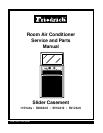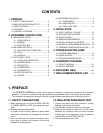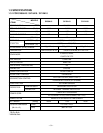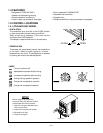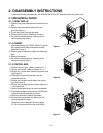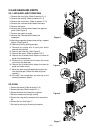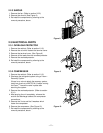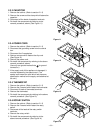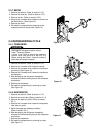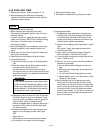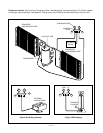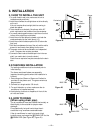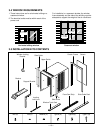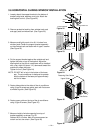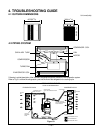
—9—
2.3.7 MOTOR
1. Remove the cabinet. (Refer to section 2.1.2)
2. Remove the turbo fan. (Refer to section 2.2.1)
3. Remove the fan. (Refer to section 2.2.2)
4. Remove the 4 screws which fasten the motor from
the Motor Mount. (See Figure 15)
5. Remove the motor.
6. Re-install the components by referring to the
removal procedure, above.(See Figure 15)
2.4 REFRIGERATING CYCLE
2.4.1 CONDENSER
1. Remove the cabinet. (Refer to section 2.1.2)
2. Remove the 4 screws which fasten the brace.
3. Remove the 4 screws which fasten the condenser
and shroud. (See Figure 16)
4. Remove the 2 screws which fasten the condenser
and base pan.
5. After discharging the refrigerant completely,
unbraze the interconnecting tube at the condenser
connections.
6. Remove the condenser.
7. Re-install the components by referring to notes.
(See Figure 16)
2.4.2 EVAPORATOR
1. Remove the cabinet. (Refer to section 2.1.2)
2. Remove the control box.(Refer to section 2.1.3)
3. Remove the upper air guide. (Refer to section
2.2.1)
4. Remove the 2 screws which fasten the evaporator
from lower air guide.
5. Move the evaporator sideways carefully.
(Refer to section 2.2.1)
6. After discharging the refrigerant completely,
unbraze the interconnecting tube at the evaporator
connections.
7. Remove the evaporator.
8. Re-install the components by referring to notes.
(See Figure 17)
Figure 15
Figure 16
Figure 17
Discharge the refrigerant system using a
Freon
TM
Recovery System.
If there is no valve to attach the recovery
system, install one (such as a WATCO A-1)
before venting the Freon
TM
. Leave the valve in
place after servicing the system.
CAUTION



